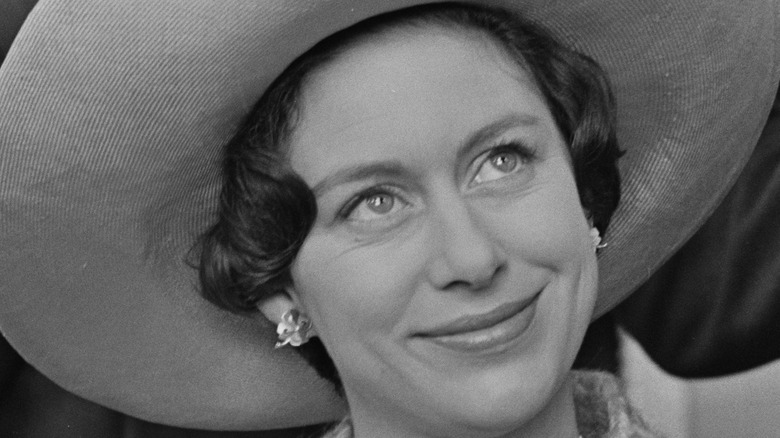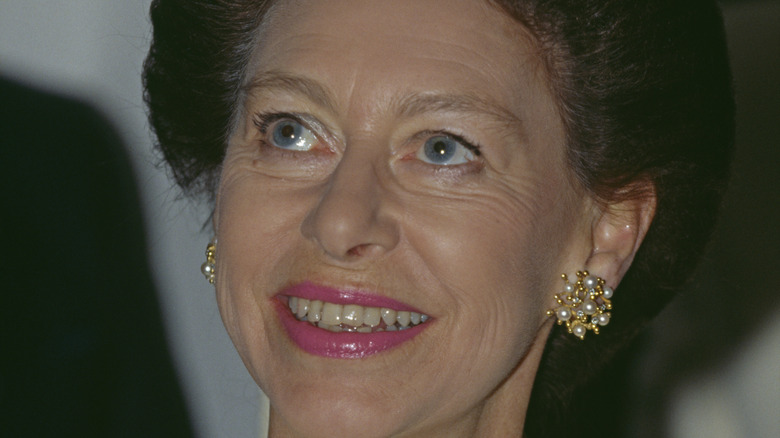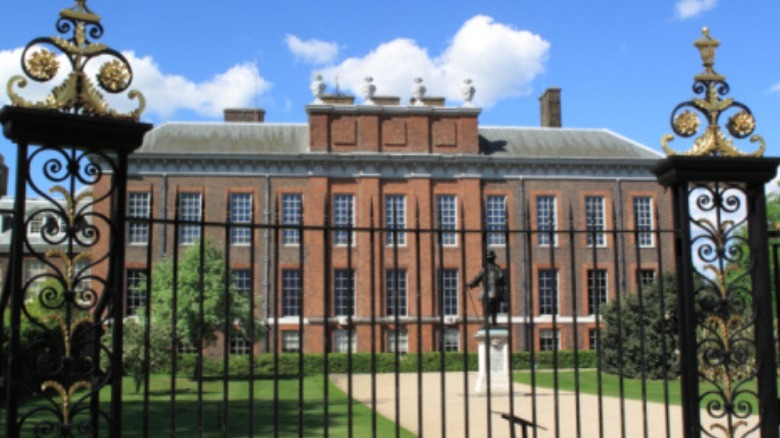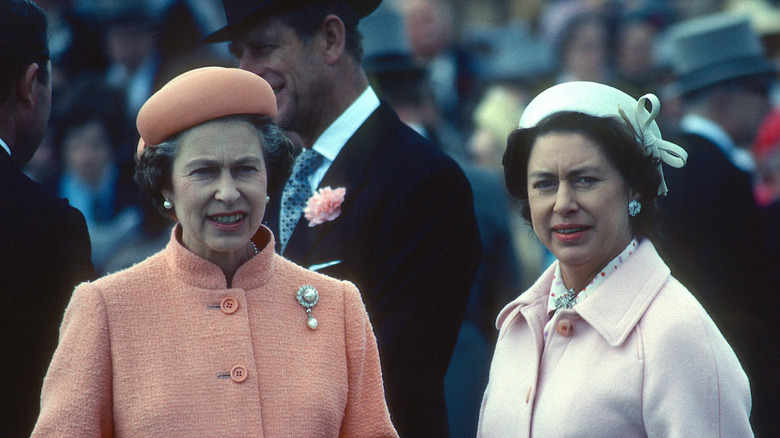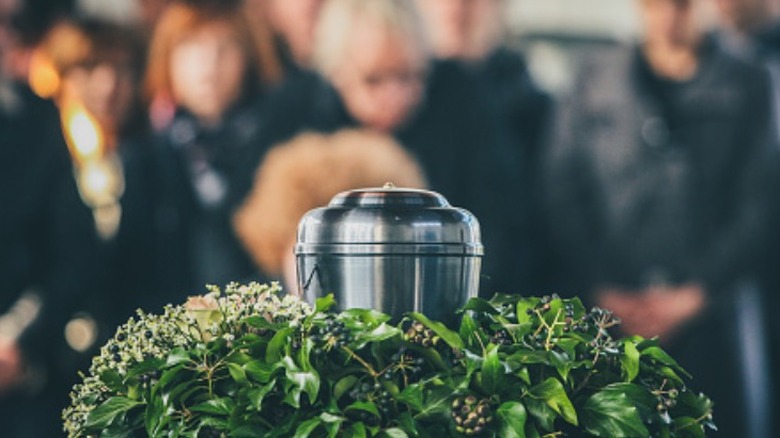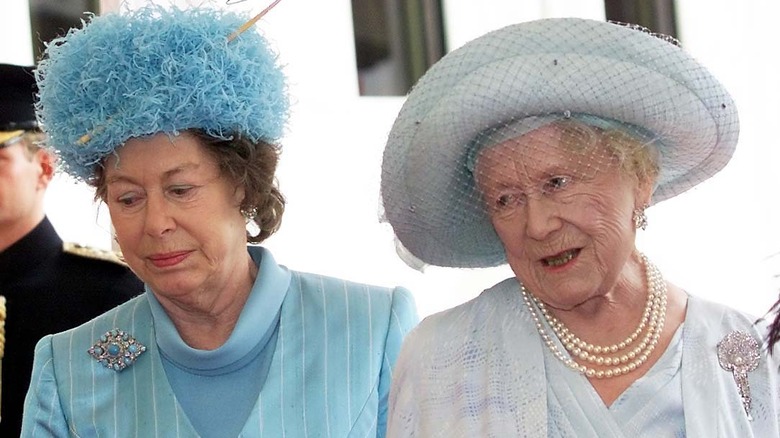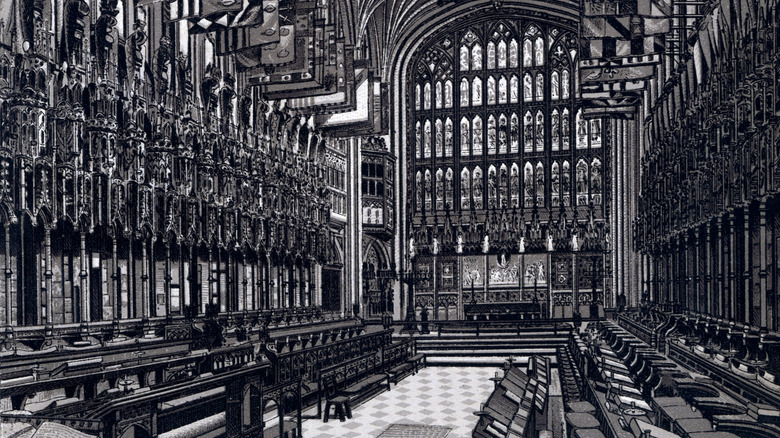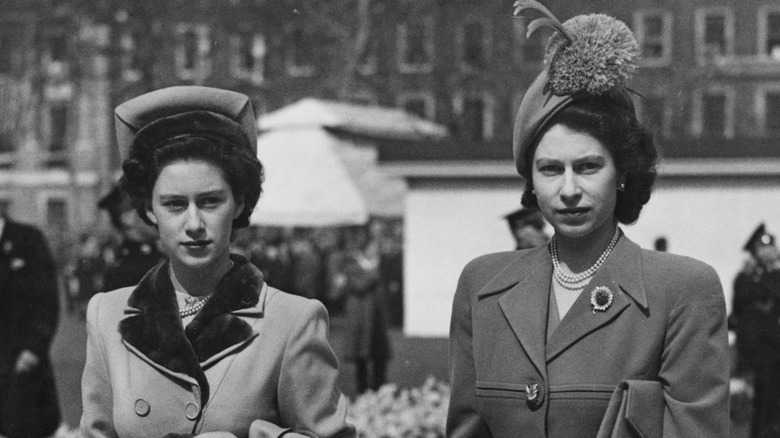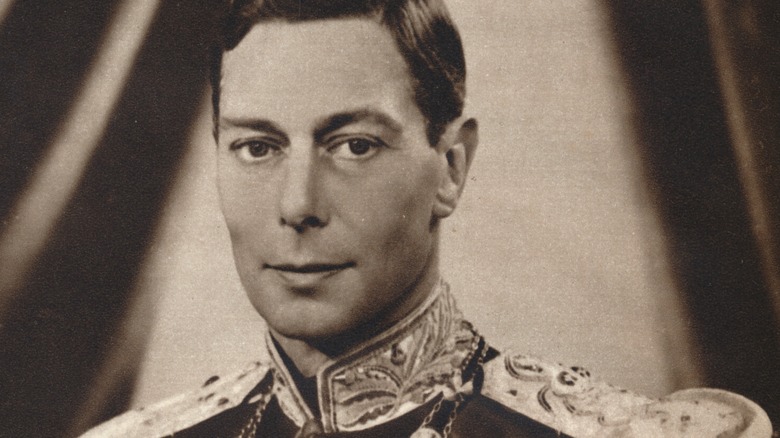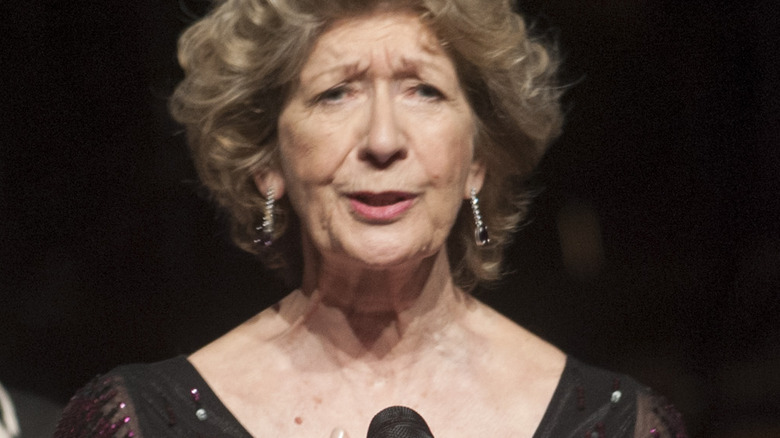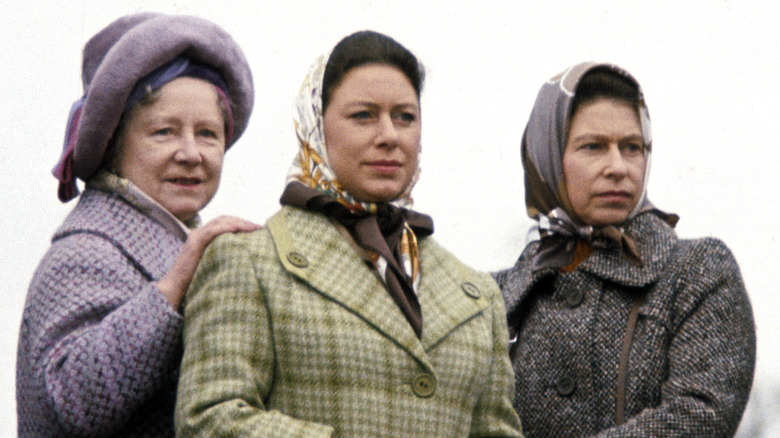A Look At The Funeral Of Queen Elizabeth's Sister, Princess Margaret
When Princess Margaret died on February 9, 2002, the world didn't stop as it had for Princess Diana or Margaret's sister, Queen Elizabeth II. But the media, and the public, did take note. Margaret's funeral and memorial, like her life, both followed royal tradition and bucked it, from the location of the service to the final handling of her remains.
Since Princess Margaret's childhood, friends, staff, and anonymous sources suggested that the princess, the wild and mercurial complement to her stoic and dutiful sister Elizabeth, chafed under the demands of royalty. Throughout her life, Margaret carried out public duties for the monarchy, giving up her well-publicized relationship with Peter Townsend along the way. The unhappy marriage she did make, ending in the first royal divorce since Henry VIII, came just as the deference shown to royalty by the press was giving way to tabloid culture.
Public opinion turned from sympathetic to hostile over the years, to the extent it turned her way at all. As Queen Elizabeth II had children and grandchildren, Margaret drifted further and further to the periphery of the monarchy. Along the way, she continued to be a source of scandal, despite her admonishing younger royals for their own contributions to the family's embarrassment (per The Guardian). Slowed down by age and ill health — a situation some blamed on her own hedonism — she died at the age of 71. The events that followed mirror a life that was marked by closeness and tension with Buckingham Palace.
What did Margaret die of?
Princess Margaret was 71 when she died, and she had been beset by health troubles for years. A bout of pneumonia put her in the hospital in 1993, and five years later, she had the first of a series of strokes. The first affected her speech and the third left her partially paralyzed, after an earlier injury to her feet had already affected her mobility, according to The Guardian.
Some critics implied that Margaret's ailing health was her own fault, a consequence of years spent drinking and smoking to excess, during a life spent milking her privileged status in British society. That the princess indulged in alcohol and tobacco was never questioned, but those who knew her pushed back on the idea that she was just a pleasure-chaser. An anonymous friend told The Guardian that Margaret's substance use was typical for her generation, and if it did grow later in life, it was to cope with the tragedies she suffered. The same friend claimed that, by the late 1990s, the princess had almost entirely given up smoking and drinking, taking greater solace in her grandchildren. But her health continued to decline.
Margaret's last public appearance before her death was in a wheelchair, at the 100th birthday party of Princess Alice before Christmas 2001 (per The Guardian). When she died the following February, the cause of death was complications from another stroke.
Tributes were muted
The day after Princess Margaret's death, Prime Minister Tony Blair offered a public tribute, as well as condolences to the British royal family. Similar messages were delivered by the leaders of every major political party in Britain, the Archbishop of Canterbury, Pope John Paul II, and Rabbi Dr. Jonathan Romain. All such statements extended personal sympathy to Queen Elizabeth II, and several made brief mention of Margaret's acts of service or religious faith.
From the royal family, a public show of grief came from then-Prince Charles. In a video message shared by the Associated Press, he remembered growing up in awe of Princess Margaret's musical talents and spoke of her "wonderfully free spirit." He also noted how difficult it was for Margaret and the family to cope with the effects of her strokes and extended his condolences to anyone with a family similarly afflicted.
But as heartfelt as the messages from British statesmen, clergy, and Charles were, they weren't on the same scale as those made after Princess Diana's death a few years earlier, or the Queen Mother's death later in 2002. The reaction of the British public and media was also restrained. Reporters from The Guardian found some Britons confused about whether Margaret or the Queen Mother had died, and others at a loss to remember much about the princess. Those members of the public who did know and appreciate Margaret left flowers at Kensington Palace, or signed a book of condolence in St James' Palace.
The queen visited her coffin
Princess Margaret's funeral was held on February 15, 2002, six days after her death on February 9. During the time in between, her coffin was kept in St. James' Palace in London. But before the coffin was brought over from her home in Kensington Palace, her sister, Queen Elizabeth II, visited the body for a private farewell (per The Guardian). While her time with Margaret's coffin was only for her, the trip to Kensington Palace was the queen's first time out since her sister's death, and she tended to her family's loss before resuming regular duties. She continued to wear black during the mourning period for her sister.
The coffin was covered with a flag bearing Margaret's personal standard and decorated with white flowers. It was taken to St James' by a hearse in a procession led by two pipers, one of them being the Queen's Pipe Major. They played "The Skye Boat Song" as they escorted the coffin (per the BBC).
Compared with other royal deaths, Margaret's saw fewer tributes and mourning from ordinary Britons. They were free to visit St James' to pay their respects, and some did so. There were also online tributes through the royal family's official website, which suggested that mourners contribute to the charities and organizations the princess had supported in life. In the political realm, the House of Commons granted Margaret a minute of silence.
Margaret chose to be cremated
Princess Margaret is believed to have had a strong hand in planning her own funeral, and one key choice set her apart from tradition. Instead of a burial, Margaret wanted to be cremated. It wasn't wholly without precedent, but no member of the British royal family had opted for cremation since Princess Louise in 1939.
Lady Glenconner, a friend and lady-in-waiting of Margaret's, offered two reasons for Margaret's choice of cremation to The Scotsman. She said that the princess wanted to be interred with her father, King George VI, in St George's Chapel on the grounds of Windsor Castle. With a burial, that wouldn't have been possible, but by being cremated, Margaret would have room in the royal vault. Had she chosen to be buried, her alternative resting place was Frogmore, home of the tomb of Queen Victoria, a place Glenconner said didn't suit Margaret. "She told me that she found Frogmore very gloomy," Glenconner said.
The cremation itself was done at the local crematorium in the town of Slough. Far from getting the royal treatment, Margaret's cremation was handled as just one on the list of six for February 15, a slow day for a crematorium that averaged 15 services a day. "I hope the other five families on Friday don't get disrupted by this," registrar Roger Parkin told The Scotsman, "or I would feel very sorry for them."
The Queen Mother broke doctor's orders to attend Margaret's funeral
When Princess Margaret died in 2002, her mother, Queen Elizabeth the Queen Mother, was 101-years-old. While celebrated for her longevity, her own health had been declining for some time. When she stepped out to accept well wishes on her 101st birthday, it was figurative; she received the public from a buggy. She caught a lingering cold over the 2001 Christmas season and suffered a fall at Sandringham on February 13, two days before Margaret's funeral. With Sandringham almost three hours away from Windsor, reports were that the Queen Mother's doctors advised her not to attend (via The Guardian). They were allegedly joined in discouraging her by Prince Charles and Queen Elizabeth II.
The Queen Mother wouldn't hear of it. To cut down on travel time, she took an RAF helicopter to Windsor to see her youngest daughter put to rest. According to Hugo Vickers' "Elizabeth, the Queen Mother," an ambulance was on standby for her, and care was taken at her request to keep her from being seen in a wheelchair, even by those within the church for the service.
Just over a month later, the Queen Mother also passed away. She joined her husband, King George VI, and Margaret in the royal vault of St George's Chapel at Windsor Castle, though hers was a considerably more publicized and viewed funeral.
By royal standards, it was a quiet service
Princess Margaret did not have a state funeral. Hers was intended to be a private affair. In royal circles, that translated to 450 mourners, with several hundred members of the public gathered outside Windsor Castle, according to The Guardian. If the guest list was large for the average person, the private nature of the funeral was evident in other ways. The public presence at Windsor was considerably less than the masses who had arrived to pay their last respects to Princess Diana a few years earlier, and a smaller reception than the Queen Mother would receive later that year.
Besides Margaret's children and the family of Queen Elizabeth II, the mourners included her ex-husband, Lord Snowdon. Poet laureate Andrew Motion was asked to mark Margaret's passing with a poem. It was but one sign of the princess's lifelong patronage of the arts; many of her mourners were artists and musicians (per The Guardian). They, and the rest of the congregation, took tea at Windsor Castle after the service.
But no artist nor child nor sovereign sister accompanied Margaret's coffin to the crematorium at Slough. Only a few members of staff attended that service, by the princess's own design. Margaret was fourth in line for cremation on the day, behind Slough locals. Her ashes were kept and later interred in the royal vault of St George's Chapel at Windsor Castle when her mother was buried there.
The queen cried at the funeral
Queen Elizabeth II's relationship with Princess Margaret was, as with any sibling relationship, lifelong and complex. Though Elizabeth was four years older, in their earliest days, they were brought up as if they were twins, according to royal biographer Andrew Morton (via Vogue). Born into royalty, they and their father were nevertheless not in direct line for the throne and spent part of their childhood without that responsibility hanging over them. For the rest of their lives, Margaret would privately call her sister by her family nickname, Lilibet.
When their uncle, Edward VIII, abdicated, Elizabeth became heir and then queen, which added a wrinkle to her relationship with her sister. Elizabeth was naturally inclined to stoicism, Margaret to exhibitionism, and that dynamic translated into their public reputations. Well into adulthood, there were reports of Margaret's jealousy at coming second to her more guarded sister, despite publicly supporting her. The queen's role in Margaret's doomed romance with Peter Townsend was another source of tension, though, according to Morton, Elizabeth was much more on her sister's side than rumor and dramatization have had it.
The queen lost her sister and her mother in 2002. After the Queen Mother's death, she gave a public address thanking the public for their condolences but did not mention Margaret. Privately, said Morton, she felt she couldn't bring up her sister without crying. Margaret's funeral earlier that year was one of the few times anyone observed the queen grow emotional in sight of the public.
Margaret's funeral was also a royal anniversary
Princess Margaret's funeral was held on February 15, 2002, in St. George's Chapel on the grounds of Windsor Castle. Margaret's cremation and the relatively small size of the service both broke from royal tradition. But St. George's Chapel, which saw construction begin in 1475 and finish in 1528, has long been the site of services and interments for British royalty. Henrys VI and VIII, Charles I, William IV, and four Georges are buried there, including Margaret's father, George VI (per the BBC).
Margaret's death was also connected to her father's in another way, besides their final resting place. Her funeral was the 50th anniversary of his own. George VI died on February 6, 1952, at just 56-years-old, and his funeral was held on February 15. It broke tradition in its own way, being the first royal funeral to be televised. But as a reigning sovereign, king of Britain during World War II, and the last emperor of India, his was a state funeral, steeped in ceremony and well-attended by the public, government ministers, and his fellow monarchs.
Some older Britons, who lived through George VI's funeral and remembered Margaret as a young princess, found the scale of her service lacking. But most features of the funeral, including its relatively small and unpublicized nature, were by Margaret's choice.
The memorial service was dominated by music
In life, Princess Margaret was known as a patron and devotee of the arts, music among them. At her funeral, music of her choice was played in addition to traditional hymns and laments. Having told the BBC once that her favorite piece of music was "Swan Lake" by Pyotr Tchaikovsky, which was included in her service, as was Johannes Brahms' second symphony.
A few months later, the late princess' musical tastes would leave their mark on another ceremony. On April 20, 2002, a few weeks after the funeral of the Queen Mother, a memorial service was held for Margaret in Westminster Abbey to mark the end of the mourning period for her and her mother. Like her funeral, it was a limited occasion by royal standards, but it still saw 2,000 attendees compared to the 450 at the funeral itself, according to The Guardian. Prime Minister Tony Blair was in attendance along with the royal family. Speeches given on the occasion noted Margaret's commitment to the arts.
But words took a backseat to music, as the service centered around a performance of Gabriel Fauré's "Requiem." The Academy of St Martin in the Field's 40-piece orchestra was brought into the abbey for the occasion, and the choirs of three different churches sang together. The performance of the "Requiem" featured noted opera stars Dame Felicity Lott and Bryn Terfel. All of this was done per Margaret's stated wishes.
She and the Queen Mother got a 10-year memorial service
Princess Margaret's funeral and memorial service in 2002 weren't the last tributes shown to her by the British monarchy. Ten years later, a private memorial service was held for the royal family in St. George's Chapel, commemorating both Margaret and Queen Elizabeth the Queen Mother (per the BBC). It was attended by Queen Elizabeth II, Prince Philip, Prince Charles and Camilla, Prince Harry, Anne the Princess Royal, Margaret's children, and the Duke of York and his family. From outside royal circles came some of Margaret's friends, including Tom Stoppard and the Queen Mother's biographer.
Speaking at the service was David Conner, the Dean of Windsor. Most of his words were spent on the ties between members of the congregation and the deceased. "Each of us here this morning will cherish some special personal memories, memories that awaken sentiments of affection and respect," he said, according to the BBC. But the dean also acknowledged what he called "faithfulness to the nation" shown by Margaret and the Queen Mother.
